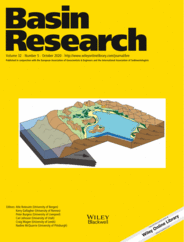
Full text loading...
 , Daniel Tentori3
, Daniel Tentori3 , Kathleen M. Marsaglia4, Luisa Pinto1,5
, Kathleen M. Marsaglia4, Luisa Pinto1,5
Sediment provenance analysis of the sand and silt size fractions of ODP site 861 (46ºS, offshore Patagonia) provides insights into erosion and ice drainage of the Patagonian Ice Sheet during the Middle to Late Pleistocene. Focus of erosion during this time period is related to a combined climatic and structural influence on glacial erosion. Temporal variations in sediment provenance contemporaneous with a change in the stratigraphy of this site suggest a re‐organization of ice extent and drainage towards the ocean around 240 kyr ago. These results contribute to constrain ice dynamics of the western side of the Patagonian Ice Sheet during the Pleistocene.
Pleistocene glaciations have promoted important landscape transformations as a result of high rates of erosion and rapid sediment evacuation to adjacent marine basins. In the Patagonian Andes the role of the Patagonian Ice Sheet on landscape evolution, in particular the spatial patterns of glacial erosion and its influence on sediment fluxes, is poorly documented. Here, we investigate the Middle and Late Pleistocene sedimentary record of the continental slope from Ocean Drilling Program (ODP) Site 861, offshore Patagonia (46°S), to evaluate the link between glaciations, mountain range erosion and continental margin strata formation. Petrographic analysis of the sand‐size fraction (0.063–2 mm) and ɛNd and 87Sr/86Sr measurements in the silt‐size fraction (10–63 µm) indicate that glacial erosion over the last 350,000 years has focused within the Patagonian Batholith, with a minor influence of a proximal source to the drilling site, the Chonos Metamorphic Complex. This shows that erosion has focused in the core of the northern Patagonian Andes, coinciding roughly with the location of the Liquiñe‐Ofqui Fault Zone and the zone of concentrated precipitation during glaciations, suggesting a combined climatic and structural control on glacial erosion. Temporal variation in the provenance signal is contemporaneous with a marked change in the stratigraphy of ODP Site 861 that occurred after the glaciation of MIS 8 (~240 kyr ago). Before MIS 8, a restricted provenance signal and coarse lithofacies accumulated on the continental slope indicates spatially restricted erosion and efficient transfer of sediment towards the ocean. In contrast, very high provenance variability and finer continental slope lithofacies accumulation after MIS 8 suggest a disorganized expansion of the areas under erosion and a more distal influence of ice sediment discharge to this site. We argue that this change may have been related to a re‐organization of the drainage patterns of the Patagonian Ice Sheet and flow of outlet glaciers to the continental margin during the last two glaciations.
]
Article metrics loading...

Full text loading...
References


Data & Media loading...

